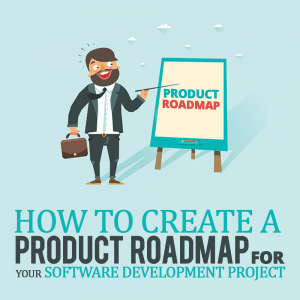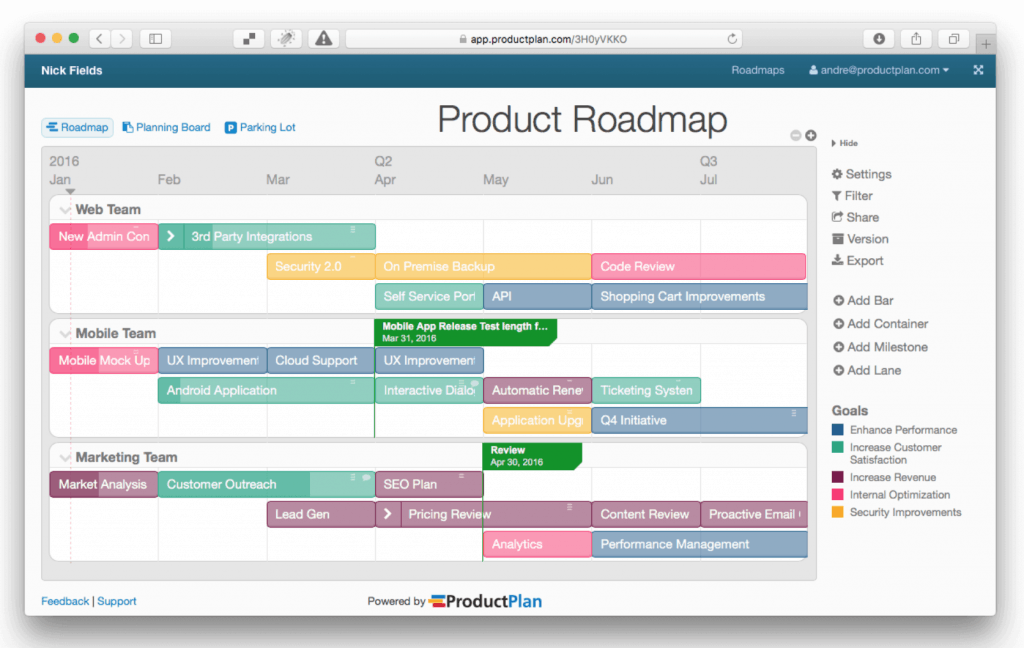 Many new products are launched every day with a focus on solving people’s problems.
Many new products are launched every day with a focus on solving people’s problems.
Companies strive to launch products faster to market and be the first ones in their niche. This gives them the competitive edge over other companies, and it also enables them to take an early-mover advantage.
However, it is not that easy. It is very risky and requires following a lot of steps. Of course, the key drivers for success tend to be early and continuous feedback from stakeholders, automation testing, and test-driven development, but guess what?
Roadmapping tops them all.
To be honest, “roadmap,” “milestone,” and “product owner” are relatively new words to us, and there are still many people who are not sure what they mean.
However, Agile methodology is a must nowadays for a successful product launch, so it’s crucial that you know what a roadmap is, why it is so important for Agile project management, what the key benefits are, and most importantly, key tips on how to create it.
What Is a Product Roadmap?
In today's world, it is extremely important to track progress, manage expectations, and keep people informed about upcoming actions and plans.
A product roadmap is an excellent tool because it acts as a strategic plan that describes the likely development of the digital product over the next period of time. It supports the product’s goals, vision, and priorities, and helps to keep their stakeholders aligned. Moreover, it fosters transparency in order to manage customer expectations.
Let’s look at what a roadmap is in more detail.
A roadmap is a visualization of what actions are needed to help your team achieve its goals. It is like a GPS for your business. It helps make your vision clear for everyone on the team, creating a detailed plan that includes both short-term and long-term goals, ways to achieve these goals with specific technology solutions, and foresight for how a product or solution will evolve over time. Product owners, for instance, use roadmaps to outline future product functionality and when new features will be released.
It gives a detailed picture of a project’s deliverables as well as a clear overview of what is expected to happen at certain times during the project’s lifecycle. It keeps track of project milestones and helps with the team’s coordination and communication.
How to Create a Product Management Roadmap
OK, but how do you create one, right?
Let's look at the key steps:
1. Big-picture analysis
Look at the long-term goals, vision, overall situation of your company, and the market. Here, you analyze your company and think about what to focus on over the next quarter, six months, and year and decide where you want to spend time and resources.
2. Product strategy
You should be thinking about a variety of issues at this stage, such as the business goals your product will achieve, what kind of customers will use the product, what problems the product will solve, the available budget, deadlines, and major product differentiators that make this product stand out from the crowd. Here it is absolutely crucial to ensure that everyone is working toward the same goal and has the same vision for the project.
3. Project plan definition
Next, you define what the project is and create a project plan to guide the execution of the project. All actions should be described together with the deadlines and milestones. For example, let’s look at an initial stage of a mobile app project: Registration and login will be done by July 1st, Facebook integration will be done by July 5th, Whatsapp integration will be done by July 10th, Instagram integration will be done by July 15th, and so on. There are dozens of useful tools to do the project planning, some of which you will find later in the article.
4. Roles and responsibilities
It is absolutely a must to identify people responsible for the project execution as well as key stakeholders who take active parts in the product roadmap. The idea is that everyone knows who is responsible for what.
5. Project risks
The risk management part is always very important as it can actually impact your deadline. Here, you list down all possible issues and come up with the solutions to prevent and solve them.
Let me give you an example. If today is July 3rd and you need to have Facebook integration done by July 5th, you can clearly see you’ll be late. Therefore, you need to have a backup plan, and it can be merely increasing the number of people involved in the project.
Your solution could be to ask a project manager for one more developer for a few days to speed up the process. If you establish a backup plan in advance, then you can solve the issues quite efficiently. If you don’t have a plan B, then you will likely fail to deliver functionalities on time.
6. Generate the roadmap
Scope, time, and resources are clear. Now, it’s time to actually create the roadmap. This is when you can use a tool like Jira or ProductPlan to analyze the velocity of your team and estimate the backlog in terms of number of hours and days. The main idea is to create a realistic forecast for you to use.
To see what a roadmap can look like, examine this example below:

7. Validation
Share your roadmap with your team and make sure they approve the timing. Sometimes, people have different velocity with achieving tasks than what you’ve estimated. Maybe developers think that it will take them longer to program a login feature than you think. Marketing guys are also stakeholders, and maybe there is a crucial event taking place in three months where you need to have certain functionalities done, and it means you need to have more developers in a team to meet the deadlines.
8. Improvement
Get customer and stakeholder feedback and keep improving. You can always do something better. You can get feedback from stakeholders by organizing retrospective meetings. As for customers, simply ask them for their opinions, read reviews, and create surveys.
Top Tools for Roadmap Creation
Nowadays, we have tools for everything and roadmap creation is not an exception.
Let’s look at the best and most popular ones:
1. Aha!
More than 150,000 company leaders use Aha! It is a cloud-based software that helps product and company builders link their powerful strategy to their team's work and create visual roadmaps. Right now, it is one of the top product roadmap software in the world. Their goal is to help people build products with conviction.
2. ProductPlan
ProductPlan is the easiest way to plan, build, and communicate your product roadmap. It helps bring the entire product strategy together in one place and offers a one-month free trial. Thousands of product owners worldwide, such as Microsoft, Starbucks, and Spotify use ProductPlan to visualize and share their product strategies across their entire organization.
3. Smartsheet
Smartsheet is a cloud-based project management platform in a familiar spreadsheet layout. It is very easy to store all your data and documentation and to collaborate with team members directly in the sheet. You can also create a customizable product roadmap and save time. Smartsheet has a pre-built template called “Feature Prioritization and Roadmap with Gantt” that helps you organize your project goals, upcoming features, and attachments.
4. Jira
Jira is a well-known Agile roadmap planning tool developed by Atlassian. It provides bug tracking, issue tracking, and project management functions. For Apiumhub, we use Jira and are very satisfied with it. Everything is in one place. Absolutely an amazing tool to plan, track, and release great software.
Benefits of Creating a Roadmap

- Sets purpose and communicates how the product should be developed over the upcoming weeks and months.
- Helps with feature prioritization, which is extremely important to ensure your team works on the right things at the right time and as efficiently as possible without losing time on something that could hinder the process.
- Links business strategy and market data with product and technology decisions.
- Reveals gaps in product and technology plans.
- Helps to set a realistic timeline and the right milestones.
- Mitigates the risks.
- Enhances the visibility of the project to all the stakeholders and improves communication. Since it is available to everyone, it ensures everyone stays on the same page and keeps everything under control.
Based on our experience, we are convinced that a product roadmap is a must for efficient software development and a successful product launch. In our case, roadmaps help us focus on the right things, create an Agile ecosystem, meet deadlines, and make our stakeholders satisfied. Hopefully it will also help you!
